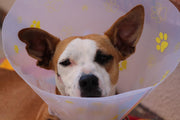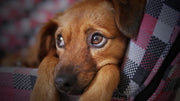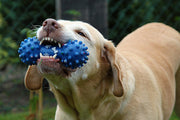
Sanitary Dogs on the Battlefield. And what battlefields...
In 2017 we commemorated the hundredth anniversary of the Battle of the Chemin des Dames. A rather pretty name for an initiative of the French army's chief commander, General Nivelle—an initiative that cost the lives of 200,000 Frenchmen in just a few weeks of this terrible War-14... The Zouaves and the Senegalese riflemen, 16,500 in number, were the first to charge following the artillery fire on April 16, 1917. At 6 a.m., they were ordered to leave the trenches, and mired in mud, they became the first victims of German machine guns.

By 7 a.m., observers knew the battle was lost. The Zouaves and the Senegalese riflemen didn't even have time to wonder what they were doing there in the snowy spring: 7,000 of them were killed on the first day...
Is it inappropriate to speak of dogs when men mattered so little? They paid their tribute to this needless war, this European civil war, just as it is said. This war also reaped havoc on nascent cynology. Some promising breeds never recovered, whether they were used in the conflict or not.

Many dogs, like true soldiers, served the country well. They were requisitioned somewhat haphazardly, entrusted to soldiers who knew nothing about them, while experienced trainers were eager to take care of them. Misused and exploited, but exploited nonetheless... In "Les Chiens de France, Soldiers of the Great War," a book published in 1919, Paul Mégnin, one of the founders of cynology and a valiant officer, criticizes the incompetence of the administration and the general staff: "At the Ministry of War, the direction of the service had been entrusted to a true officer, Mr. Rondecuir, who knew nothing about dogs or their training and who refused to take an interest in the function he was charged with..."
Protected
There were no shortage of dog lovers in the French army. But it was not to them that the dogs were entrusted... So, to whom were they given? To the first comers: rank-and-file soldiers who gradually became users and soon realized that dogs were excellent sentinels. There are numerous accounts of infantrymen who owe their lives to the regiment's dog, who timely warned them of the enemy's approach.

They were given to soldiers who did not fit the profile of users but who grew attached to the dogs. Thus, the dogs became regiment mascots and benefited from a sort of protection. Well-fed, well-housed, and... kept away from fire. These dogs, the majority, were not true war dogs but companion dogs. They were still very useful to the soldiers, bringing them some comfort in the hell of the trenches.
Soldiers in the Great War, from all armies, behaved similarly with horses. In "All Quiet on the Western Front," Erich Maria Remarque recounts the words of a soldier, miraculously surviving under gunfire, outraged at bringing horses to the front: "War is for men, not for horses, after all..." When it was learned that the dogs at the military kennel in Campo Santo were not receiving all the care they deserved, the Central Canine Society took concern. It fulfilled its role of worrying about the fate of dogs. Other institutions were there to worry about the populations surviving in suffering and scarcity...
Requisitioned
Initially, the dogs requisitioned for the Army were mostly sentry dogs. There were also draft dogs. After the very cold and snowy winter of 1915-1916, two officers went to Alaska and brought back 440 sled dogs in anticipation of a war of movement that would follow trench warfare. These dogs, with their mobility, would be more effective than horses or donkeys for transporting machine guns and ammunition. There were also messenger dogs that crossed the spaces between enemy lines under fire. Most importantly, there were sanitary dogs tasked with locating and signaling the wounded on battlefields. They proved to be very useful at the Chemin des Dames, as we shall see why.

Before that, it's important to note that there were very few combat dogs during the Great War, for emotional reasons as we've just mentioned, and also for tactical reasons. Since the invention of firearms, and even since crossbows came to complement or replace bows, sending a dog to attack was no longer in military doctrine. In antiquity, hand-to-hand battles were frequent, and dogs were formidable for combatants and especially capable of causing panic among horses.
In medieval battles, as weapons became more sophisticated, the use of dogs fell somewhat into disuse. By 1914, no one was advocating the idea that sending one or more dogs to assault the enemy would sow panic in their ranks or could neutralize the soldier with his finger on the machine gun trigger.
Another reason why assault dogs did not have a place in trench warfare was ignorance. In France in 1914, training a dog for frontal attack was not yet mastered. This technique was beginning to be developed in Belgium, the precursors of ring sports. But Belgium was occupied and out of combat. There was, however, Truc, a Bouvier des Flandres nicknamed "The Boche Ripper," led by a mountain infantryman. Both posed for a photo published in Paul Mégnin's book. But no photo of Truc directly engaging, so to speak, with an enemy soldier is found, nor is there any testimony to that effect. It's a pity, once again, if one may say so, because Truc, trained in Belgium, was probably a genuine attack dog of the Great War, one of the few...
The last reason, and not the least, is that dogs that could assist soldiers emerging from trenches for hand-to-hand combat were no more prepared than the others for this type of combat. And no one was motivated to train them: after all, one should not be helped by dogs to do the dirty work... If it is the duty of men to go to combat, the place for dogs is in the kennel. Dogs, before being soldiers' auxiliaries, are mascots and a comfort. And God knows how much the Poilus, as Maurice Genevoix called them, needed comfort, even if brought by a dog...
Engaged
While war dogs rarely appeared in actual battles, they proved to be very useful on the battlefield for locating and even providing first aid to the wounded, such as fresh water. Fierce engagements like the Battle of the Chemin des Dames experienced periods of respite, if not truce, that each side respected fairly properly, used to recover their dead and, more importantly, their wounded.

The battlefield of the Chemin des Dames, an apparently easily accessible plateau from a certain height where one could spot the lying bodies, became, on the morning of April 16 after incessant artillery fire from April 13 to 15 in preparation for the infantry assault, a landscape transformed into holes and mounds, made even more impassable by snow and waterlogged soil.
The unfortunate infantrymen, burdened with gear meant to sustain them for 6 days, never reached the progression speed of 100 meters in three minutes decreed by General Mangin. They got stuck in the mud from their first steps, and the Germans, relatively unaffected by the previous days' artillery fire, shot them down like clumsy ducks.
An hour after its launch, the Battle of the Chemin des Dames was lost, or at least could no longer be won. To recover the countless wounded, stretcher-bearers didn't know where to head as they couldn't see them. It was the sanitary dogs that helped them. And in 1917, these dogs were finally effective. German dogs were sent to search for the wounded, which they signaled by barking as soon as they found them.
This marked the birth of the "Search and Bark" method, still found today in RCI and field ring programs. The French technique was different: no barking that could be heard by the enemy, but the dog had to bring the stretcher-bearer an object belonging to the discovered wounded. This technique was questioned because some soldiers were strangled by their helmet straps, which the dog had grabbed.

Sanitary dogs had to learn a different method: when discovering a wounded, the dog had to take in its mouth a bringsel hanging from its neck and return to the stretcher-bearer to guide him. This bringsel, a term probably invented by Captain Tolet, who had studied the work of dogs in Germany before the war.
For it was he, a great fan of Bouviers des Flandres, who created in 1895 a society for the study of training sanitary dogs, along with the stockbroker Louis-Alfred Lepel-Cointet. Léon-Alphonse Tolet published a book on the training of sanitary dogs in 1912.
It wasn’t that he had a visionary idea: he learned that the Germans were already preparing them and that the English had used them with some success during the Boer War in South Africa in the early 20th century.
The French "inventors" of the sanitary dog were hardly helped or even encouraged. It wasn't until 1911 that the first military kennel for training sanitary dogs was created in Avon-Fontainebleau.
This was the first step towards the entry of dogs into the French army. At that time, the Germans trusted Baron Max Von Stephanitz, who created the German Shepherd, a military dog breed adopted by all armies of the world and which remains the most popular and used today, even though it faces competition from the Malinois.
In France, despite the information and recommendations, the high command was astonishingly skeptical and inert. At the start of the conflict, the French army had only 250 dogs, exclusively sanitary dogs. Germany had 6,000...
During 1915, things evolved as information about the effectiveness of dogs used by other allied or enemy armies surfaced. At the end of the year, the War Dog Service was finally created by decision of Alexandre Millerand, Minister of War. The dogs were donated by individuals or breeders.
There was a shortage of dogs in the army, but dogs from the Paris pound continued to be euthanized under a regulation from 1882. It took the persistence of General, later Marshal, Lyautey to circumvent this obsolete regulation, incorporate them into the French armies, and offer them a new life. 3,000 dogs from the Paris pound were thus saved from euthanasia. And like all the others, they were demobilized in 1919 without any further recognition.
The French army's general staff, proud of what the American intervention had allowed them to call a victory on November 11, 1918, still had learned nothing. In 1919, the War Dog Service was dissolved, and it was not until 1937 that thoughts returned to war dogs.
With yet another war lagging for the French army, but also for the French war dog cynotechny. During the Great War, 15,000 dogs were engaged in the French army. 5,500 were killed.
The Lost Opportunity of the Bouvier des Flandres
Paul Mégnin, one of the most influential cynophiles of his time, particularly appreciated the Bouvier des Flandres, which made its first official appearances in France in 1912. Captain Tolet, the father of the French sanitary dog, was also a staunch advocate of the Bouvier.
It is a powerful dog without being too heavy, a courageous and very resilient dog, suitable for defense, tracking, and also a good draft dog. If the French army's general staff had decided at the end of the Great War to create and promote a breed as Germany had done in the late 19th century, it is likely the Bouvier des Flandres that would have been chosen…
Instead, military cynotechny was abandoned for nearly 20 years. But history cannot be rewritten. Another breed will catch up and even soon surpass the German Shepherd in all the armies of the world at the end of the 20th century, the Malinois. But the Malinois is a creation of civilian users and owes nothing to the military. This does not detract from its qualities, as everyone agrees.
Sidebar 2
"One Does Not Shoot at an Ambulance"…

The search work of dogs and stretcher bearers is not hindered by the belligerents on either side. It is a custom of war. Occasionally, the firing must stop.
Then bodies are recovered, or what remains of them, and the wounded are brought back. These brief moments of respite are only interrupted by mutual agreement on each side of the trenches.
Certainly, no quarter is given on the battlefields, but dogs wearing a white bib with a red cross are not shot at, nor are the stretcher bearers. The popularity of the phrase "One does not shoot at an ambulance" could stem from this era.
Author: Jean-Yves Reguer
Related Posts
How To Treat A Dog Hot Spot: Easy Proven Treatment and Home Remedies
If your dog has been licking, biting, or scratching a lot recently, he may have developed a hot spot. Hot spots are one of the most common skin conditions in dogs, especially during summer. Hot spots are incredibly itchy and can spread r...
Hay Fever in Dogs Symptoms and 7 Proven Ways to Help Your Dog
You probably have heard of hay fever in humans, also called allergic rhinitis. This condition affects between 10 and 30 percent of the U.S. population. Symptoms and severity vary but often include sneezing. Dogs can also get hay fever, a...
The 3 Healthy Habits To Distract Your Dog From Licking, Chewing, and Scratching
Many dogs, just like us humans, sometimes resort to obsessive behavior. It may be out of boredom, anxiety, or an underlying issue. Common dog obsessive behaviors The goal of this article is not to discuss obsessive behaviors such as: H...




